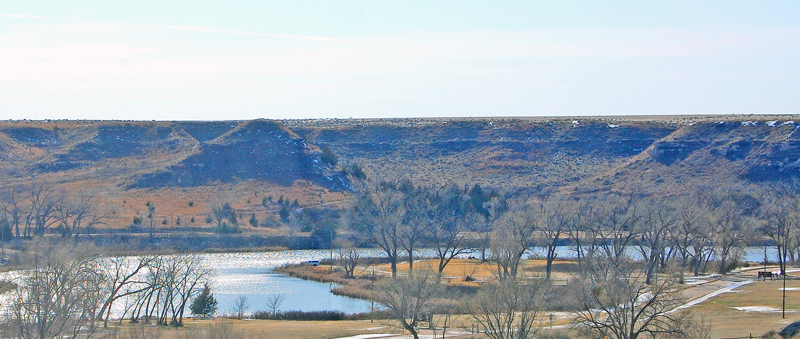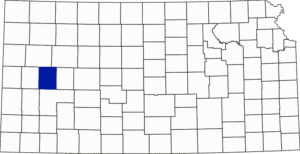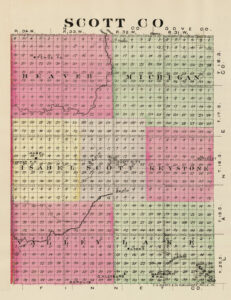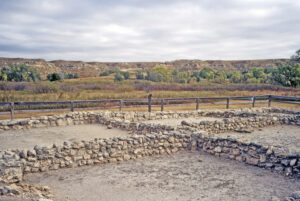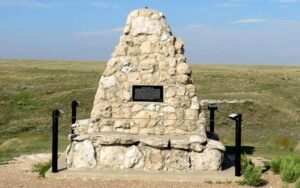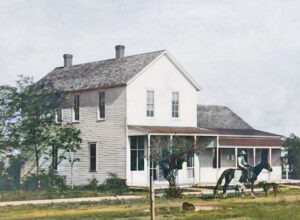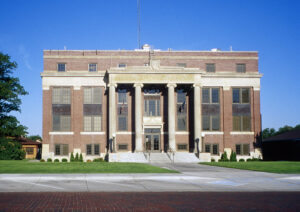Towns & Places:
Scott City – County Seat
Shallow Water – Extinct
Lake Scott State Park & Wildlife Area
The Ghost of White Woman Creek
Scott County, Kansas, is in the western part of the state, and its county seat is Scott City, the only incorporated city in the county. As of the 2020 census, the county population was 5,151, and its total area was 718 square miles of Kansas prairie, of which 718 square miles was land and 0.1 square miles was water.
It is the third county east of Colorado, the fourth south of Nebraska, and the fourth from the southern boundary of the state. It is bounded on the north by Logan and Gove Counties; on the east by Lane County; on the south by Finney County, and on the west by Wichita County.
The county covers 720 square miles and 460,800 acres, with an elevation of 2,979 feet. Scott County is rectangular, measuring 30 miles north to south and 24 miles wide. The general surface is an undulating prairie with a few sand hills. Four-fifths of the county is of billowy prairie, with long reaches of low-lying bottom lands skirting the clear-winding streams, which are generally flanked by low hills and occasional picturesque bluffs. In the center of the county, a few miles to the south of Scott City, is the famous White Woman Basin, a tract of low, bottomland of 25,000 acres.
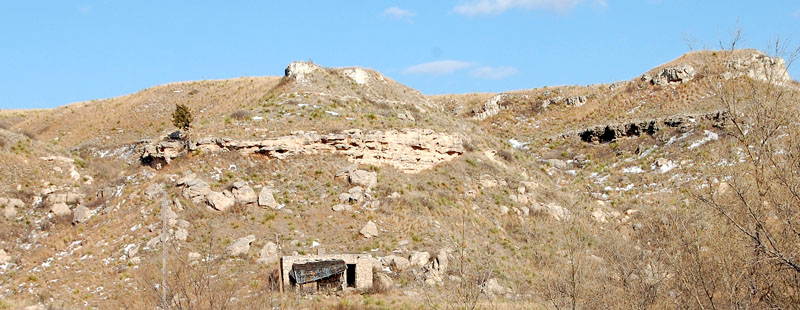
Scott County, Kansas Landscape by Kathy Alexander.
The principal stream is Ladder Creek. It enters from the west, flows east for about nine miles, then turns north into Logan County, where it empties into the Smoky Hill River. White Woman Creek enters from the southwest and flows east and northeast to the center, where it sinks beneath the surface in the midst of a large basin which is filled only in wet seasons. The annual overflow of the river, which has its source in the foothills of Colorado, floods the basin with its surplus waters, which quickly sink again into the bed of the lost stream. It is claimed that so strong is the current of this subterranean river, at flood time, that the sound of its swift waters can be heard distinctly some distance from the mouth of several of the sinkholes.
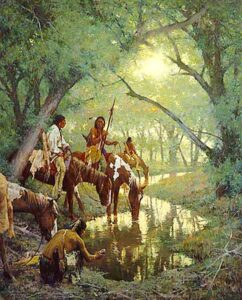
Cheyenne at the Disappearing Creek, called White Woman by Howard Terpning, photo courtesy Swoyer Fine Art & Collectibles.
Ladder and White Woman Creeks have numerous spring brook tributaries reaching out in different directions, which have always supplied pure water for the stockman. The county also boasts many fine flowing springs, and wells of both hard and soft water are easily accessible at depths of 15 to 50 feet for irrigation purposes. Quarries of building stones are found in certain sections of the county, including the white, gray, and cream-colored magnesian limestone. Sandstone, gypsum, and cement rock also exist in limited quantities. Native timber was limited to small belts and groves along the streams.
Like all of the counties in Kansas, Scott County’s first inhabitants were nomadic plains Indians.
The Dismal River Culture inhabited the Ladder Creek area before written history began. Taos Indians escaped Spanish rule around 1664 and settled in what is now Lake Scott State Park. These Indians lived here for a few years, around 1701. Pueblo El Quartelejo is roughly translated as ‘old barracks’ or ‘distant quarters’. Initially, it was a stone-and-adobe building, 32 by 50 feet, divided into seven rooms. A Spanish expedition led by Lieutenant Juan de Archuleta soon chased down the Pueblo Indians and returned them to Taos, New Mexico.
In 1706, Juan Uribarri claimed the spring-fed valley that protected El Quartelejo for Spain and called it San Luis Province. This is the only known pueblo in Kansas and is the farthest north and east known in America.
El Quartelejo is believed to have been used by Frenchmen as a trading post prior to 1724.
Scott County was created by an act of the legislature in 1873. It was named in honor of United States Army Major General Winfield Scott, a hero of both the War of 1812 and the Mexican-American War. Scott served under every president from Thomas Jefferson to Abraham Lincoln, spanning 14 administrations, and was an active-duty general for 13 of them, totaling 47 years of service. Historians rank him highly as both a strategist and a battlefield commander.
For several years, it had no population and therefore required no local form of government; however, it was attached to Ford County for judicial purposes. Very soon after people began to settle there, a petition signed by the required number of citizens was presented to the board of county commissioners of Finney County, requesting that Scott County be organized as a municipal township and attached to Finney County for judicial purposes. Scott County was organized as a township of Finney County, and Scott Center (present-day Scott City) was designated as the place of transacting public business.
The first settlers came into the county in 1874. The first white women were Mrs. M.E. DeGreer and her daughter, Mrs. Ida Eastman, both widows.
The Battle of Punished Woman Fork is the site of the last battle between the United States Cavalry and the Indians in Kansas. Chief Dull Knife and Little Wolf of the Northern Cheyenne, and their people, slipped away from the reservation in Oklahoma in 1878. They were heading to Yellowstone when military troops became aware of their presence. The troops met up with the Indians in the canyons along the southern edge of what is now Scott County State Park on September 27, 1878. Little Wolf led the Indians in battle, while Lieutenant-Colonel William H. Lewis, commander at Fort Dodge, led the troops.
The women, children, and elderly hid in the cave while the warriors fought the advancing soldiers. Lieutenant-Colonel William H. Lewis was wounded in the thigh. That night, the Cheyenne escaped, crossing the Smoky Hill River and heading northwest. The following day, Lewis was placed in a military ambulance, and the soldiers made their way to Fort Wallace, Kansas, about 40 miles to the northwest. Along the way, he died of his wounds, becoming the last Kansas military casualty of the Indian Wars. In the meantime, the Cheyenne continued to Yellowstone after slipping away during the night.
In 1884, the ruins of a prehistoric pueblo were discovered in Scott County about 12 miles north of Scott City.
That year, settlement really began when people from the East came to seek homesteads advertised by the government. The homesteader could obtain a patent for the land after living on and improving it for five years. Mrs. M.E. DeGeer and her daughter, Mrs. Eastman, became the first permanent settlers in October 1884.
By 1885, 91 people lived in Scott County, and many of them had come from Illinois, Iowa, and Missouri. Scott City was founded in September 1885 by the Scott City Town Company, composed of Dr. Hall, F.A. Parsons, S.W. Case, Mrs. M.E. De Geer, Mrs. F.A. Parsons, Mrs. I.L. Eastman, W.E. McLain, Mrs. D.F. Hall, and Messrs Sangster and Swan, who filed their charter in that month and soon after laid out the town. They changed the name from Scott Center to Scott City at this time.
A township election was held in Scott Centre on July 7, 1885, and the following officers were elected: Trustee, Charley L. Waite; Treasurer, C.R. Swan; Clerk, M.H. Bailey; Road Overseer, W.E. McLain; Justice of Peace, S.W. Case and Joseph Hollister; Constable, Ira J. Woif.
In June 1886, Charles Reed was appointed enumerator of Scott County by the governor. The returns were made on June 29 and showed a population of 2,675, of whom 701 were householders. The property was valued at $364,063, of which $109,030 was real estate. Governor Martin proclaimed on the same day that he organized the county, named Scott City, located at the county’s geographical center, as the county seat, and appointed the following officers: County Clerk, Charles S. Reed; Commissioners, Marion Cunningham, A.H. Kilpatrick, and Eugene McDaniels.
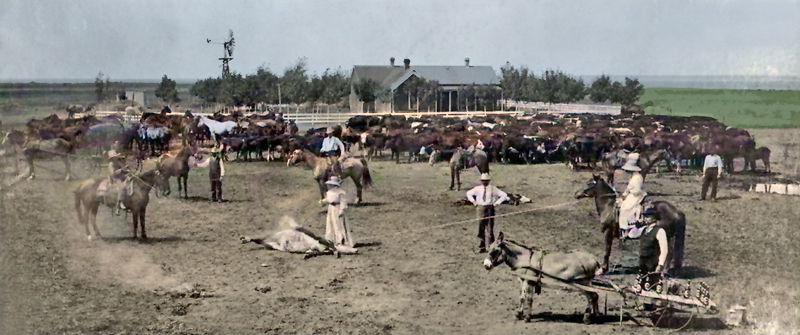
Branding cattle in Scott County, Kansas.
The county was declared organized on July 5, 1886, and that day, the appointed commissioners and county clerk met in a special session, with Eugene McDaniel as chairman. The county was divided into the following townships: Beaver, Isbel, Keystone, Lake, Michigan, Scott, and Valley.
An election was called to be held on August 10, 1886, and at that time the following officers were elected: Charles Reed, County Clerk, W.R. Hadley, Treasurer; B.F. Griffith, Register of Deeds; S.T. Burgess, Clerk of the District Court; J.F. Daniels, Sheriff; Lulu Boling, County Superintendent; Dr. J.F. Bond, Coroner; Eugene McDaniel, Commissioner of 1st District; H.M. Connor, Commissioner of 2nd District; C. Garrett, Commissioner of 3rd District. The county seat was located at Scott Center by unanimous vote.
The post offices were Grigsby, Manning, Modoc, Pence, Scott, and Taft. The Missouri Pacific Railroad entered the county from the northeast, crossed southwest to Scott City, and then continued directly west into Wichita County. A branch of the Atchison, Topeka & Santa Fe Railroad from Great Bend entered from the east and crossed west to Scott City, where it terminated.
The original frame courthouse was constructed in 1888 on the Northeast corner of the courthouse square.
The county’s population in 1890 was 1,262. During the next three or four years, the population decreased somewhat due to the hard times. The county commissioners visited the state capitol in Topeka, Kansas, to secure state aid, but were unsuccessful. In 1893, there were 300 families, of whom only 75 survived the winter.
The ruins of Pueblo El Quartelejo were visited by professors in 1898. S.J. Willston and H.T. Martin of the University of Kansas derived many interesting facts and recovered numerous relics. In it were found stone, flint, and bone implements, mealing stones, pots, herds, a quantity of charred corn, and other things used and found in the Indian pueblos of the Rio Grande in New Mexico.
In 1900, the population was 1,098.
In 1910, the county’s population was 3,047. The assessed valuation of the property at that time was $5,913,442, with average wealth per capita at $1,940. At that time, less than half of the land in the county was cultivated. The value of farm products was $607,766, and the value of livestock on hand was $768,013.
The current Scott County courthouse was constructed in 1924 on the square where the original courthouse had stood, which had been torn down.
Scott County’s population peaked in 1980 at 5,782.
Two school districts have territory in the county. Scott County USD 466 has almost all of the land, while one small piece is in Healy Public Schools USD 468.
©Kathy Alexander/Legends of America, updated October 2025.
Also See:
Sources:
Blackmar, Frank W.; Kansas: A Cyclopedia of State History, Vol I; Standard Publishing Company, Chicago, IL 1912.
Fort Hays State University
Kansas Post Office History
Scott County, Kansas
Wikipedia

